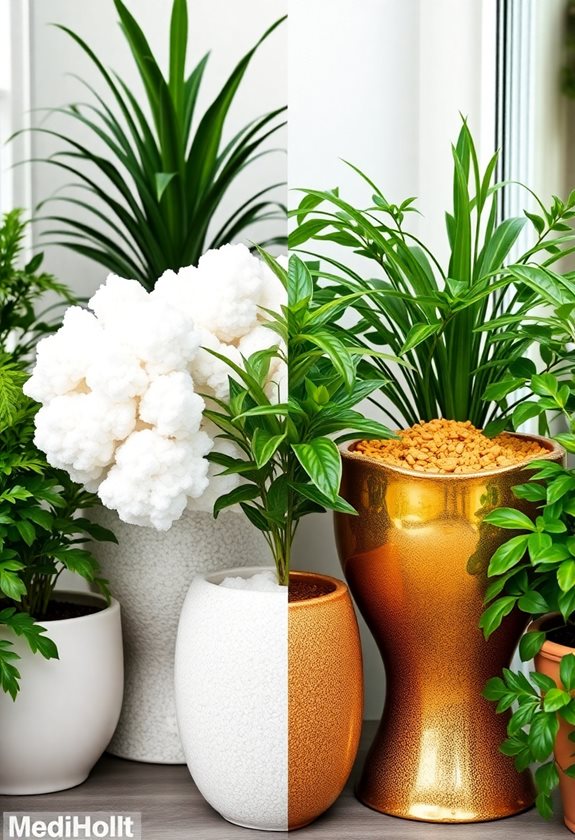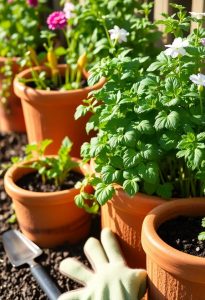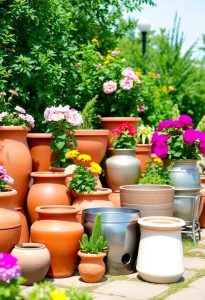When choosing between perlite and vermiculite for your container gardens, there are five key differences to evaluate! First, perlite’s volcanic origin means it offers great aeration, while vermiculite retains moisture like a sponge. Second, perlite’s pH is neutral and lacks nutrients, but vermiculite packs in minerals. Third, perlite prevents soggy roots, making it perfect for drainage, and fourth, vermiculite is ideal for seed starting. Finally, mixing them gives your plants a balanced home! Curious about the perfect ratios?
Design Highlights
- Perlite is a volcanic glass that enhances aeration, while vermiculite originates from mica and retains moisture when heated.
- Vermiculite can hold three to four times its weight in water, making it ideal for hydration, unlike perlite which retains moisture less effectively.
- Perlite improves drainage and aeration, suitable for plants like succulents, while vermiculite is best for moisture-loving plants and seed starting.
- Nutrient content varies, as vermiculite contains essential minerals like magnesium and potassium, while perlite is mostly inert.
- The ideal pH level for nutrient uptake is around 6.0 to 7.0, with the mix of both materials supporting vibrant plant growth.
Composition and Origin
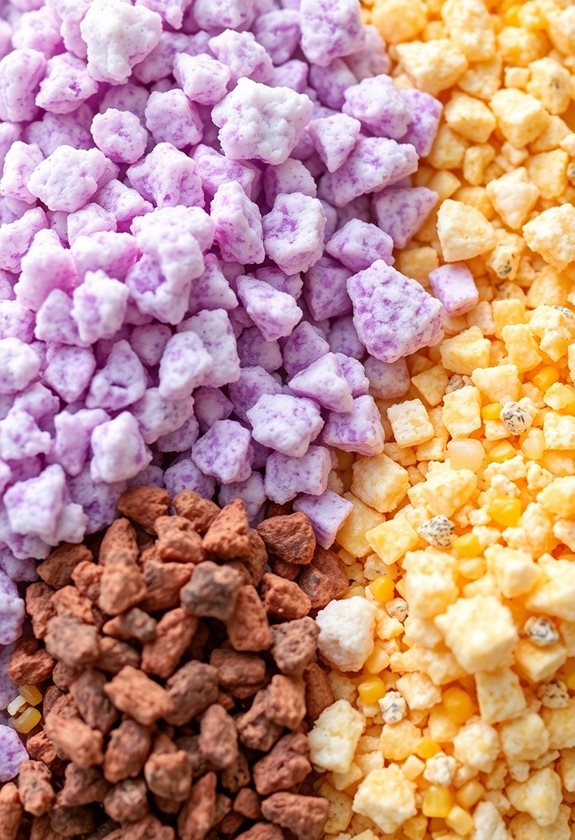
When you plunge into the world of container gardening, understanding the materials you use can make a big difference in your plants’ success. Perlite, a volcanic glass, is super lightweight and offers excellent aeration. Vermiculite, on the other hand, originates from mica and expands when heated, making it great for moisture retention. Think about it—do you want your plants to breathe well or hold onto water? Why not use both? Mixing them creates a balanced environment! Additionally, using an organic potting mix can further enhance the health of your plants. So, next time you’re at the garden center, remember: the right composition can lead to thriving plants. Excited yet? Let’s dig deeper!
Water Retention Capabilities
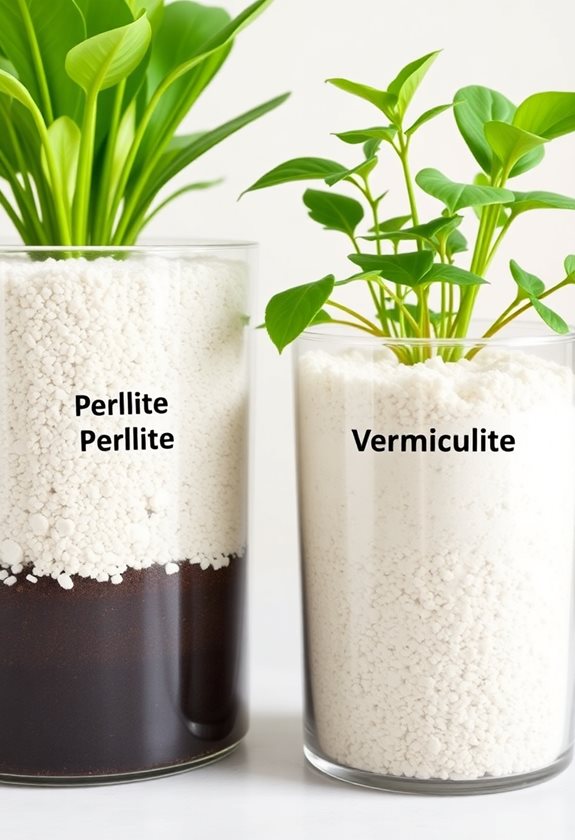
You might be wondering why water retention is so important for your container plants. Well, keeping those roots happy and hydrated is vital! Vermiculite shines in this area, holding up to three to four times its weight in water. This means your plants can sip water gradually, which is like a spa day for them. On the other hand, perlite struggles a bit, only retaining moisture without soaking it up completely. So, if you’re aiming for a lush garden, consider mixing vermiculite into your container soil. It’s a game-changer! Avoiding high-maintenance plants can also help ensure your garden thrives with minimal effort. Who wouldn’t want their plants to flourish? Happy gardening!
Aeration and Drainage Properties
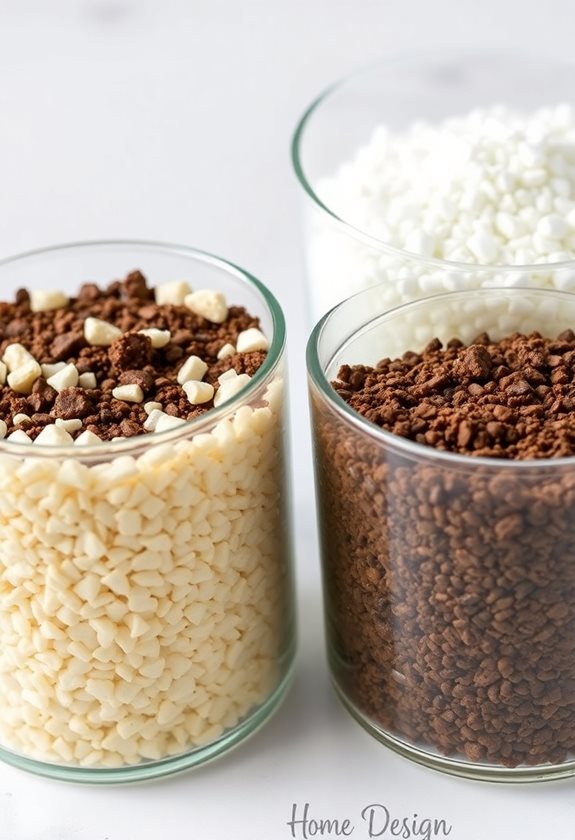
Aeration and drainage are like the dynamic duo of container gardening! You want your plants to thrive, right? Perlite and vermiculite each play distinct roles in ensuring ideal aeration and drainage.
- Perlite boosts aeration, promoting healthy root growth.
- Vermiculite retains moisture while still allowing water to flow through.
- Combining both can create the perfect balance for your plants.
When you mix these ingredients, you’re not just filling a pot—you’re creating a thriving environment! Ever struggled with soggy roots? You won’t with the right mix! Proper drainage is essential to keep your plants healthy and thriving! Let’s get those plants dancing in their containers!
Nutrient Content and Ph Levels
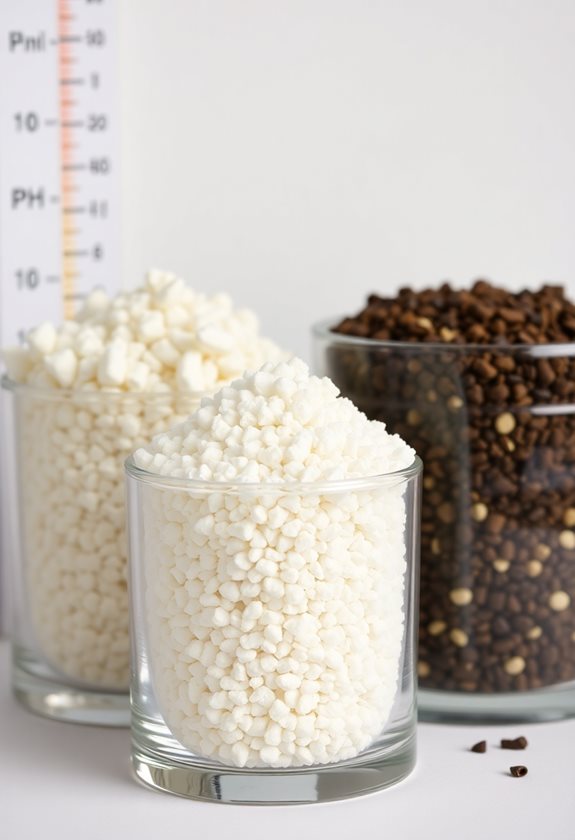
Just like a good recipe needs the right ingredients, your container plants thrive on balanced nutrient content and appropriate pH levels! Perlite is primarily an inert medium, lacking significant nutrients, while vermiculite contains some essential minerals like magnesium and potassium. This makes vermiculite a better choice for nutrient retention. Aim for a pH level around 6.0 to 7.0 for ideal nutrient uptake—most plants love this range! Have you ever seen a plant sulking due to poor pH? It’s heartbreaking! So, consider mixing perlite and vermiculite to strike the perfect balance—your plants will thank you with vibrant growth and blooms! Additionally, using a custom potting mix can enhance the overall health of your container plants.
Best Uses in Container Gardening
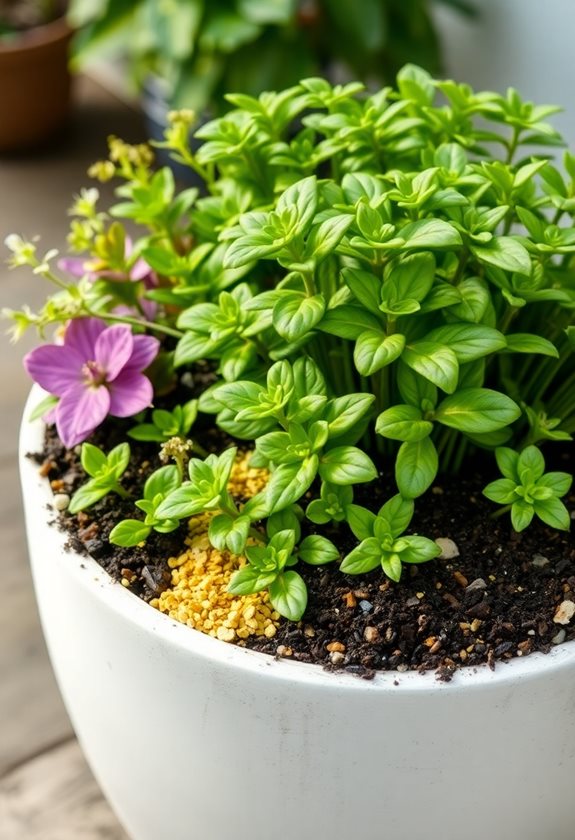
When it comes to container gardening, knowing how to use perlite and vermiculite can make all the difference in your plants’ success! Both materials serve unique purposes that can elevate your gardening game. Here’s how you can best use them:
- Perlite: Improve drainage and aeration in potting mixes, perfect for succulents and cacti.
- Vermiculite: Retain moisture and nutrients, making it ideal for seed starting and leafy greens.
- Combination: Blend both for a balanced potting mix, ensuring healthy, thriving plants! Additionally, the right mix can enhance nutrient absorption and overall plant health.
Frequently Asked Questions
Can Perlite and Vermiculite Be Mixed Together for Container Plants?
Absolutely, you can mix perlite and vermiculite for your container plants! Did you know that using both can increase moisture retention by up to 30%? It’s like giving your plants a cozy blanket! Just combine them in equal parts for a well-draining, moisture-holding mix. This combo helps prevent root rot while ensuring your plants get the nutrients they need. Have you tried this duo before? It’s a game changer for any garden!
Are There Any Environmental Concerns With Using Perlite or Vermiculite?
When it comes to perlite and vermiculite, you might wonder about environmental concerns. While both materials are generally safe, perlite production can be energy-intensive, and its mining can disrupt ecosystems. Vermiculite, on the other hand, often comes from a source that’s been linked to asbestos, which raises health concerns. Always look for products labeled as safe! Isn’t it fascinating how our gardening choices impact the planet? Let’s make environmentally friendly decisions together!
How Do Perlite and Vermiculite Affect Soil Temperature?
Think of your garden as a cozy blanket, where temperature plays a vital role in keeping your plants comfy. Perlite and vermiculite act like insulation—perlite reflects heat, keeping soil cooler, while vermiculite retains warmth. This balance can impact growth! When planting, consider using both to optimize temperature control. Have you ever noticed how a chilly night affects your plants? Understanding these dynamics can make your gardening journey more rewarding and fun!
Can I Reuse Perlite or Vermiculite From Previous Plantings?
Absolutely, you can reuse perlite and vermiculite! Just make sure to clean them first. Rinse them to remove any old roots, pests, or diseases. Think of it like spring cleaning for your garden! After rinsing, let them dry out before adding them to your new mix. It saves money and helps your plants thrive. Plus, recycling those materials feels great, doesn’t it? Happy gardening! 🌱
Are There Alternative Materials to Perlite and Vermiculite for Container Gardening?
Did you know that about 30% of garden soil can be made up of organic materials? If you’re looking for alternatives to perlite and vermiculite, you’ve got some great options! Consider coconut coir, which retains moisture but drains well, or pine bark, which adds aeration. You could even use shredded leaves or compost! Have you tried them? They can really give your container plants the boost they need. Happy gardening!

